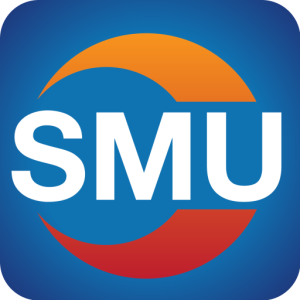
Steel market chatter this week
Earlier this week, SMU polled steel buyers on an array of topics, ranging from market prices, demand, and inventories to imports and evolving market chatter.

Earlier this week, SMU polled steel buyers on an array of topics, ranging from market prices, demand, and inventories to imports and evolving market chatter.
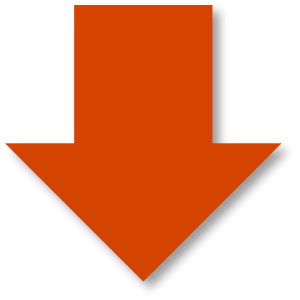
Sheet prices slipped again this week on a combination of moderate demand, increased imports, and higher import volumes.
Let's take a collective deep breath ::in:: and ::out::... And we're back. But where exactly are we? Are steel prices going up or down? Is demand really decelerating or is it an illusion? How is the market navigating the new mill pricing mechanisms?
Nucor moved its published consumer spot price (CSP) up again this week.
Nucor’s Consumer Spot Price (CSP), a legitimate mill offer price, is a potential disruptor to North American steel sheet commercial and procurement strategies. We will dive into the details of what we think the CSP is and why we believe it is a potential disruption to how the North American sheet market operates.
Steel Market Update’s Steel Demand Index fell five points to a 12-month low and moving further into contraction territory, according to our latest survey data.
The latest SMU market survey results are now available on our website to all premium members. After logging in at steelmarketupdate.com, visit the pricing and analysis tab and look under the “survey results” section for “latest survey results.” Historical survey results are also available under that selection. If you need help accessing the survey results, or if […]
Here’s something I didn’t expect to see this week: SMU’s Current Buyers’ Sentiment Index dropped to its lowest point since August 2020.
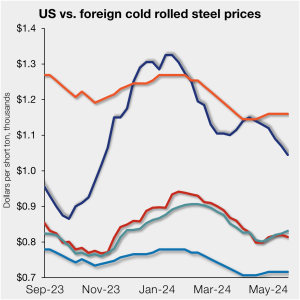
Offshore cold-rolled (CR) coil prices remain a cheaper option over domestic product, even as US CR coil prices tick lower, according to SMU’s latest check of the market.

US hot-rolled (HR) coil prices declined again and now stand nearly even with offshore hot band on a landed basis.
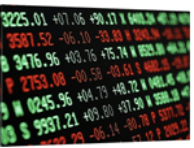
Sideways and range-bound describes the US steel derivatives market over the past week, though the monthly picture shows a more notable decline in front-end flat prices. Week-over-week saw the June futures contract firm slightly, from $770 per short ton (st) to $780/st as of Thursday, May 23’s provisional close. However, the contract was down by […]

Lead times on most steel products tracked by SMU held steady or contracted this week compared to two weeks earlier, according to our latest market survey.

Steel prices eased for both sheet and plate products this week, according to our latest canvass of the market
The CRU US Midwest hot-rolled (HR) coil index is a dominant and established price benchmark in the US. Many steel-buying contracts are linked to ‘the CRU,’ as it’s commonly called. But how does it work?
Nucor upped its published consumer spot price (CSP) this week.
The recent decline in US hot-rolled (HR) coil and longs prices has further restricted demand for imported material. Despite the decline in US sheet prices, CR coil and HDG imports remain attractive. While demand for imports of longs products has been limited, buyers have increased imports of wire products to avoid wire rods’ higher tariffs. […]
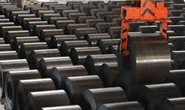
US hot-rolled (HR) coil prices saw further declines this week, while foreign prices were steady to slightly higher in the three regions we monitor
SMU surveyed our market contacts this week about steel prices, demand, and the overall marketplace. Below are some of the buyers' responses in their own words to help you get a feel for current and future market conditions. Demand is a big topic of discussion currently. Is it steady, falling, or on the upswing with summer construction heating up? As you can see from the answers below, it depends on who you ask. One buyer’s response sums it up pretty well: “I still see the marketplace as soft/stable with some segments busy, while others tread water.”
Steel Market Update is pleased to share this Premium content with Executive members. For information on how to upgrade to a Premium-level subscription, contact info@steelmarketupdate.com. Flat Rolled = 57.8 shipping days of supply Plate = 58.3 shipping days of supply Flat Rolled US service center flat-rolled steel supply edged lower in April, though shipments continue to […]
Our spot price is little changed this week after moving sharply lower last week on the heels of Nucor’s unexpected price cut. Here’s one thought on that trend: Nucor's weekly HR price (aka, its “Consumer Spot Price” or CSP) has to date functioned almost more like a monthly price.

Steel prices were overall mixed this week, according to our latest check on the market. Sheet prices were flat to down, while plate prices inched up. SMU indices on hot rolled, cold rolled, and galvanized are now down to the lowest levels seen since November.
Nucor chose to hold its consumer spot price (CSP) for hot-rolled (HR) coil steady this week after stunning the market last week with a significant price decline. The steelmaker said in a letter to customers on Monday morning that its $760-per-short-ton (st) CSP base price for HR coil is effective immediately. The price is unchanged from the CSP announced on May 6 but down $65/st from $825/st April 29.
What's the tea in the steel industry this week? Here's the latest SMU gossip column! Just kidding... kind of. Yes, some of the comments we receive in our weekly flat-rolled market steel buyers' survey are honestly too much to put into print. Some make us laugh. Some make us cringe. Some are cryptic. Most are serious. We appreciate them all. Below are some highlights from our survey results this week. Some of the comments that we can share with you are also included, in italics, in the buyers' own words, with minimal editing on our part.

Offshore cold-rolled (CR) coil prices remain much less expensive than domestic product, even as domestic prices have slipped to a six-month low, according to SMU’s latest check of the market.
Steel Market Update’s Steel Demand Index fell eight points, and back into contraction territory, an indication demand might be slipping as prices have trended lower, according to our latest survey data.
The latest SMU market survey results are now available on our website to all premium members. After logging in at steelmarketupdate.com, visit the pricing and analysis tab and look under the “survey results” section for “latest survey results.” Historical survey results are also available under that selection. If you need help accessing the survey results, or if […]
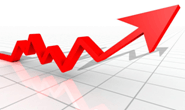
Steel prices trickled lower across the month of April for both sheet and plate products.

US hot-rolled (HR) coil prices declined again, tightening their premium over offshore hot band, and moving closer to parity.
Hot rolled, cold rolled, and plate buyers said mills are more willing to talk price on spot orders this week, while the overall negotiation rate for products SMU surveys remained level, according to our most recent survey data.
Most steel products tracked by SMU saw lead times contract this week from two weeks earlier, according to SMU’s most recent survey data.